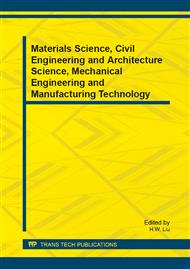p.145
p.150
p.154
p.158
p.162
p.167
p.170
p.174
p.178
Research on Initial Velocity and Penetration Ability of 50SiMnVB Steel Shell Formed Fragments
Abstract:
For 50SiMnVB steel shell formed fragments, AUTODYN-3D finite element software was applied to numerical simulate the process of fragment forming. The change law of velocity distribution of 50SiMnVB steel shell formed fragments under high energy explosive charge along the warhead axial was obtained. And the maximum velocity and penetration ability of 50SiMnVB steel shell formed fragments was researched by experiment. The result shows that, the whole process of shell breaking is about 70μs, and the velocity of shell expanding during it can be distributed to three phases called librating, accelerating and stability. The minimum initial velocity of fragments appears at where approaching detonation point, and its quantity is about 931.7m/s; The maximum initial velocity appears at where away from detonation point about 60% cylinder length, and its quantity is about 1488.3m/s. When fragment group penetrates 5mm thickness armor steel target with 1215m/s, its penetration probability is about 46.2%.
Info:
Periodical:
Pages:
162-166
Citation:
Online since:
January 2014
Authors:
Keywords:
Price:
Сopyright:
© 2014 Trans Tech Publications Ltd. All Rights Reserved
Share:
Citation:


